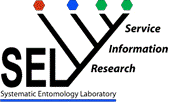Entomology Collections, General

USDA Systematic Entomology Laboratory
Document Type
Article
Date of this Version
2009
Abstract
Despite the familiarity and economic significance of Coccinellidae, the family has thus far escaped analysis by rigorous phylogenetic methods. As a result, the internal classification remains unstable and there is no framework with which to interpret evolutionary events within the family. Coccinellids exhibit a wide range of preferred food types spanning kingdoms, and trophic levels. To provide an evolutionary perspective on coccinellid feeding preferences, we performed a phylogenetic analysis of 62 taxa based on the ribosomal nuclear genes 18S and 28S. The entire dataset consists of 3957 aligned nucleotide sites, 787 of which are parsimony informative. Bayesian and parsimony analyses were performed. Host preferences were mapped onto the Bayesian tree to infer food preference transitions. Our results indicate that the ancestral feeding condition for Coccinellidae is coccidophagy. From the ancestral condition, there have been at least three transitions to aphidophagy and one transition to leaf-eating phytophagy. A second transition to leaf-eating phytophagy arose within an aphidophagous/pollinivorous clade. The mycophagous condition in Halyziini originated from aphidophagy. Our findings suggest that polyphagy served as an evolutionary stepping stone for primarily predaceous groups to adopt new feeding habits. The analyses recovered a clade comprising Serangiini plus Microweiseini as the sister group to the rest of Coccinellidae. The subfamilies Coccinellinae and Epilachninae are monophyletic; however, Sticholotidinae, Chilocorinae, Scymninae, and Coccidulinae are paraphyletic. Our results do not support the traditional view of phylogenetic relationships among the coccinellid subfamilies. These results indicate that the current classification system poorly reflects the evolution of Coccinellidae and therefore requires revision.


Comments
Published in Biological Control 51 (2009) 215–231.